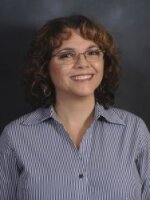For years, University of West Florida researchers have been digging for more details about the lives of the slaves who once lived and worked at the Arcadia Mill Archaeological Site in Milton.
As part of Black History Month, the latest findings will be highlighted in a weekend talk titled “In the Shadow of the Big House.”

In the presentation, Site Manager Adrianne Walker will share historical and archaeological evidence of daily life of the enslaved people at Arcadia, including recent findings from their summer 2018 excavations.
“One of the most interesting things that we were able to do in the five weeks that we were in the field was uncover the full chimney of the slave cabin that once sat there,” said Walker of their research goal to be certain of the double chimney, which was only partly visible on the ground surface. “We wanted to make sure we exposed all of it, and in doing so we found this amazing feature right in front of one of the openings.”

Walker describes a dark ovular-shaped stain, which appeared to be a small pit. Excavation of the pit revealed a large round, fist-sized piece of metal with turtle shell fragments on top of it. The artifact was sent to the UWF conservation lab for a full examination.
“Now we have figured out that it is cannon shot,” Walker said. Specifically, the ball of metal was medium sized cannon shot, not a large cannonball and not the small shot used for guns.
“Somebody obviously buried it there, but unfortunately we don’t know exactly when that might have been or maybe what the purpose is.”

There could be any number of reasons why the cannon shot was buried in the pit. But, at this point, Walker is placing more emphasis on two extremely different hypotheses.
“It could be that an African American living in that structure buried that structure there for a reason, maybe a religious reason,” Walker explained, noting that archaeologists often find things buried under structures that were inhabited by enslaved people. “So, there’s some ceremonial context that could be going on.”
Walker’s other theory of why the metal was buried under the cabin is a bit more practical, “It could have been much later and maybe somebody did it as a source of grounding before lightning rods were put on structures. Because, that cabin, we think it was built in maybe the mid-to-late 1830s and it stood until the early 2000s. So, it was used for a very long time.”
The slave cabin was adjacent to the original three-story big house, known as the Simpson House, which was built around 1835 by mill owner Ezekiel Simpson. Both structures were located on a bluff overlooking the mill complex along Pond Creek. Arcadia Mill, which was one of the first and largest water-powered industrial complexes in Northwest Florida, operated between 1830 and 1855.

Many artifacts reflecting slave life at Arcadia have included pipe and button fragments, plain ceramics, and furniture tacks. Over the years, researchers have learned a lot from historical documents, such as census records from the period.
“We know that in the earlier times of Arcadia, in the 1830s leading into the mid-1840s, it was mainly a male population; cutting the trees, working in the sawmills,” Walker said.
In 1845, the local newspaper of the day documented the owners’ trip to Virginia to purchase forty female slaves to work in Arcadia’s textile mill.
“And, it’s very interesting because you can see in the census after that, you start seeing children, children that weren’t there before. And, so we watch this population grow and change and then you start to see an elderly population.”
By the time operations ceased at Arcadia in the mid-1850s, many of the slaves there had been sent to work at their owners’ lumber mill in Bagdad. However, Walker notes there is evidence that — even years later — some blacks remained at the Arcadia homestead.
“Several months after the Emancipation Proclamation was signed, we have a Civil War era document showing that slaves were still there at the Simpson House making breakfast for Confederate soldiers,” she said pointing to evidence that a small core group of enslaved people were still there during the war between 1861 and 1865.
One of Walker’s future goals is to find out more about what happened to the enslaved blacks at Arcadia, in the decades after the industrial complex closed and slavery ended.
But, for now, her priority is to learn as much as she can about their life, at Arcadia, in order to present a more diverse, complete history of the place.
“We have a full story to tell, not one-sided, and we just want to make sure people understand what that time period was like and what it was like for everyone, not just the people who were documented in the papers or who could read or write,” Walker explained. “We want everyone to embrace this full history, whether it is turmoil or not. You know, that was not a good time in history, but we can learn from it.”
Public interpretation of the entire six-and-a-half acre Arcadia Mill Archaeological Site is underway. Already, it includes a Visitor’s Center and Museum; and a walking tour, with signage, of the former industrial complex. The Arcadia Homestead, including the new Simpson House Museum, will open next month. A ceremony to mark the occasion will be held on Saturday, March 9.
Meantime, Walker’s Black History Month talk, “In the Shadow of the Big House,” is this Saturday, Feb. 9, 11 a.m. at the historic mill site at 5709 Mill Pond Lake, Milton, FL. The program is being presented in partnership with the UWF Office of Equity and Diversity.


